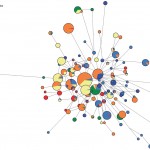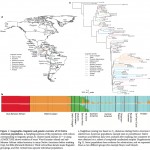How Many Germans Does It Take to Classify Amerindian Languages?
In his recent presentation on correlations between genes and myths in Eurasia and North America (see video in Russian, from 53:50 on), Vladimir Napol’skikh expressed a strong opinion on Amerindian linguistic diversity and several proposals of genealogical kinship between Amerindian…

Y-DNA hg C3* in South America and Putative Ancient Transpacific Contacts
PLoS Genet 9(4): e1003460. doi:10.1371/journal.pgen.1003460 Continent-Wide Decoupling of Y-Chromosomal Genetic Variation from Language and Geography in Native South Americans Lutz Roewer, Michael Nothnagel, Leonor Gusmão, Veronica Gomes, Miguel González, Daniel Corach, Andrea Sala, Evguenia Alechine, Teresinha Palha, Ney Santos, Andrea…

The Diversity of Tasmanian Languages
Proceedings of the Royal Society, B Biological Sciences, 2012 DOI: 10.1098/rspb.2012.1842 The Riddle of Tasmanian Languages Claire Bowern Recent work which combines methods from linguistics and evolutionary biology has been fruitful in dis- covering the history of major language families…
Typological Linguistics and Population Genetics: A Synthesis or a Controversy
Trends in Cognitive Sciences Vol 16, Issue 3, March 2012, Pages 167–173 http://dx.doi.org/10.1016/j.tics.2012.01.007 Tools from Evolutionary Biology Shed New Light on the Diversification of Languages Stephen C. Levinson, and Russell D. Gray Computational methods have revolutionized evolutionary biology. In this paper…

A Three-Wave Model for the Peopling of the Americas, or a Three-Wave Back-Migration from the Americas to the Old World
Nature (2012) doi:10.1038/nature11258 Reconstructing Native American population history Reich, David, et al. The peopling of the Americas has been the subject of extensive genetic, archaeological and linguistic research; however, central questions remain unresolved. One contentious issue is whether the settlement occurred…


Recent Comments